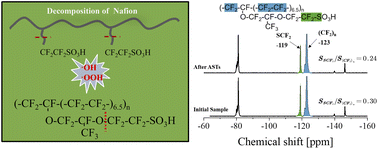New insights into degradation of Fe–N–C catalyst layers: ionomer decomposition†
Abstract
Fe–N–C catalysts can be used as a substitute for expensive and scarce platinum-based catalysts in proton exchange membrane fuel cells (PEMFCs). However, the durability of MEAs worsens as the performance loss increases after the first few hours of operation. To gain better insight into the degradation mechanism, a cesium salt of phosphotungstic acid is employed as a proton conductor to replace the Nafion ionomer in MEAs. The experimental data reveals improved performance stability. Except for degradation of the catalyst itself, the faster growth of proton resistance of MEAs confirms the degradation of solid electrolyte Nafion as the primary reason leading to fast performance degradation. By contrast, changes in the structure and morphology of the cathode catalyst layer (CCL) are not the primary reasons for the performance degradation of the Fe–N–C MEA. Furthermore, the 19F NMR peak assigned to a SCF2-linked SO3H group decreases by about 20%, providing direct evidence for the deactivation of the Nafion ionomer. The quantitative results provide a better in situ understanding of the fast degradation of the Fe–N–C based CCL attributed to the decomposition of the Nafion ionomer. In sum, these data look promising for future optimization of CCLs to match the commercialized requirement of the Fe–N–C MEA.

- This article is part of the themed collection: Journal of Materials Chemistry A HOT Papers


 Please wait while we load your content...
Please wait while we load your content...